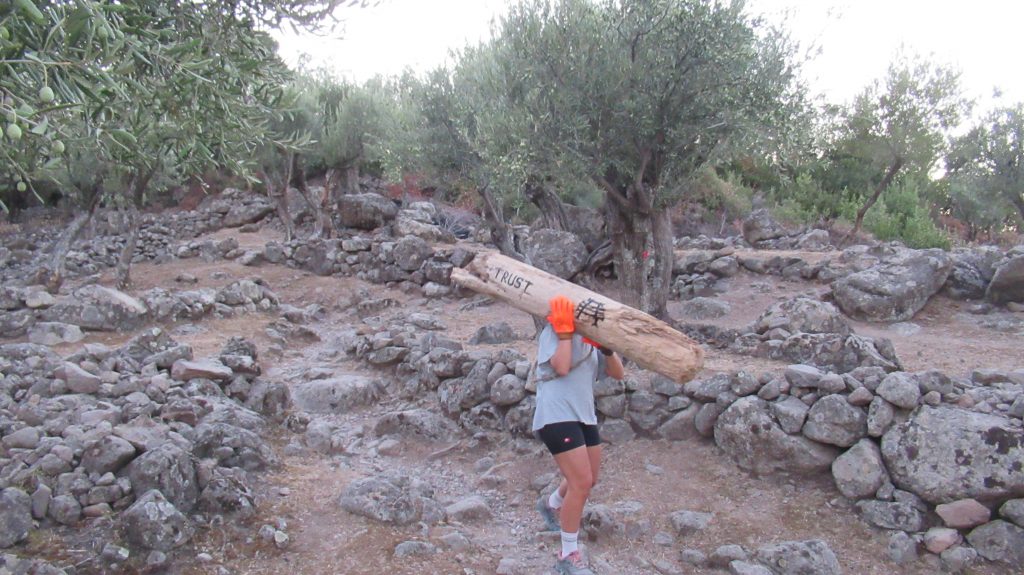
Different societal and environmental places have the tendency to create greatly varying lived spaces for their residents, depending on which country or culture they are living in. Distinct cultural backgrounds and surroundings can also influence how people engage with their environment. These environments – and the means of people to engage with or despite them – are often specifically constructed or naturally evolved over time, according to the places’ geographical topos and the peoples’ history. Yet the similarities and the universal ways to value the environmental spaces can be explored, even when the cultures and the environments themselves are far distant from one another.
This type of exploration is what the artists Walter Götsch and Eirini Tiniakou are pursuing with their latest project. Walter and Eirini are performance artists who come from somewhat different backgrounds but share a close relationship in their interests and values. Having completed his MA at the Sandberg Institute in Amsterdam, Walter (who is a Finn but whose father is German – hence the German name) has done a lot of performances, creating projects that relate to the environmental, cultural and spiritual thought. Eirini has graduated from the University of Applied Arts in Vienna, Angewandte, in the Arts and Science department, where she conducted her MA thesis on the theme of olive cultivation.
Both share the similar personal background of having grown up in the countryside. Walter grew up in the small village of Mallusjoki, which – along with its nearby lake Mallusjärvi – would later be an inspiration for his artistic works to come.
But this used not to always be the case:
– When I was young, I really hated the countryside. I wanted to go into the big city. I went to Tokyo, I was in Japan for quite a while, says Walter.
It was only later in his life when Walter became inspired by the area where he had grown up in:
– … but then, now when I get older and with Eirini, I kind of refine the value of the countryside. And I want to find similarities of the Finnish countryside and the Greek, Walter adds.
They have a common vision on what are the important values of life, which to them stems from their relationship with natural environment and their artistic projects.
– We both share an interest towards nature and discovering what it means to us and our practices, says Eirini.

Throughout the course of the interview, Walter and Eirini are very kind, chatty and eager to tell about their artistic endeavours. When it comes to their latest project in Greece, it is not something that I specifically need to ask about – understandably so, as the experience is very recent and productive. The fascinating time in Sykaminea is soon brought up by the two after being asked about their projects in general:
– I came back to Finland from Amsterdam in September 2020. I already knew Eirini a little bit, and then we made the decision that “before I come back to Finland, what if I would go to Greece, and to this island of Lesbos?” because we chose that at that time. And then I went there and then I stayed there with Eirini, and basically since then Eirini has come to Finland – multiple times, says Walter, recalling the beginnings of the project.
– And we slowly started to collaborate artistically, says Eirini.
Their latest project relates to the Hermitage in Sykaminea, a retreat for all kinds of artists that is located in the northern part of the island Lesbos. Standing in the slopes of the Mount Lepetymnos, Hermitage is located in the midst of an olive grove. The place was founded in 2016 and has been restructured since 2020. Along with the idea of being a retreat point for arts, crafts, architecture and design, Hermitage also serves to develop the local ecological infrastructure of the region. The place will be given to a trust foundation in a long term.
– In the Hermitage Sykaminea we wanted to do – on purpose – a specific performance there, Walter says.
The two were also interested in making a video of the performance, documenting the experience. The performance develops in various artistic fields, and Walter enjoys the idea of documenting the experience and subsequently transferring it to the audience:
– We do multiple different things. And I think this is kind of one for me to do a lot more in the future. Maybe the idea for the performance also to make it as a video and documented in a certain way so it’s really, more like a video. A really popular document, because at least for me the performances I have done before…. it’s really the experience, and the documentation is quite secondary, Walter says, opening the idea for another medium.
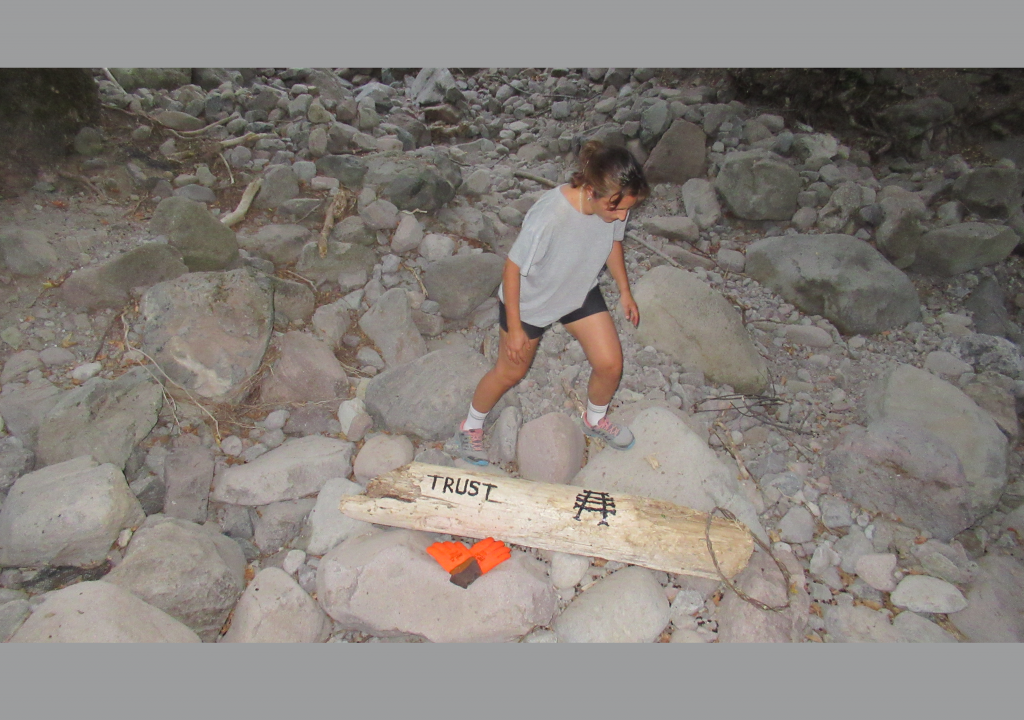
The environmental thought is very much part of Walter’s and Eirini’s ambition with their art, and something that they connect draw ideas with their inspiration of the countryside. They proceed the subject with their art, trying to maintain the experience as a comprehensive one:
– The audience was the nature, the landscape, the olive trees… and I think it was very important how we managed to experience the environment and the area. At least my practice is very much local based, it has to do a lot of where I am and what are the people doing there, how their lives are– something we share with Walter. And by observing nature every day, engaging with the environment, walking down half an hour, from the trail, path, coming up again to the mountain… this was inspiring moment for us, for the work we are developing and the work we did there. And the video certainly is a medium that can be shown easily and shared with the public and in many events, from online platforms to exhibitions, says Eirini, elaborating on the project.
When it comes to the general, broad effects the environment can have, it becomes evident that the subliminal effect on the inspiration cannot be denied:
– I think the island itself gives you a certain energy that really gives you the power and the motivation to accumulate it somehow to your work and to yourself, Eirini says.
The conversation leads to the cultural differences between Finland and Greece, regarding which Eirini starts to recall some interesting similarities (and differences) between the two countries and the countryside. Eirini thinks for a moment before replying:
– The biggest difference between the Finnish countryside or Finland and Greece is, I would say, how distant or less distant people live to each other. So, we live [in Greece] very close to each other one house next to the other, also in the countryside. But in the Finnish countryside people live much more like… your neighbour might be kilometres away. So, I think that’s a very interesting thing to notice, Eirini says.
The emphasis is clearly on the similarities though, and how the places are connected, as Eirini clarifies when I ask about the exploration of the differences between the two countries. She continues:
– But I understand what it means to be close to someone, be far from your neighbour, how do the relations form there, and how the small community or society follows the professions that people do. Like having any mounts [horses] or cows – in the case of Finland – or being only farmers or to only have goats, in that case in Greek countryside. And I think with Walter’s background [countryside] and my background that both my parents have links and nets to the Greek countryside, we have this common ground that we explore, not only artistically, but in our lives. And I think that is interconnected and it’s like a core over artistic and thought, Eirini says.
In terms of artistic work, Sykaminea provided a place where the work was conducted on its own terms and schedule. Walter addresses his general way of working which he applied in Lesbos: observing, walking around, having a general feeling of the place, getting into mood of working. If something does not work, it’s fine, something else can always be tried. Bottom line is trying to stay open to ideas.
– This is kind of how I work in general, as artist. The way of finding meaning, I find it somehow. Maybe it’s a different medium that I originally thought, but it’s okay, then I re-entangle it somehow, Walter says.
Walter and Eirini also got to meet other artists working there as well in Hermitage. With their own project though, they worked solely together.
– We’re still very early in our collaborative work, so it was important to us. I’m used to working with very big groups, where it’s more like orienting people and thinking about the certain type of choreography. We had quite a different approach on this, but I’m very satisfied, Walter says.
When we are discussing the matters of working, I ask how they feel in retrospect about the experience, whether it went as they planned or imagined, or not. Then the cultural differences of Finnish and Greek people are once again brought up. Basically, the situation revolves around the conception of time and how people manage their actions. There is a lot of punctuality going on in the Finnish culture as opposed to Greek one, as it appears:
– They [Greeks] say this date and “oh, I cannot do it today, I do it tomorrow”, and tomorrow will become the next week and maybe it will never happen. So, you have to be able to adapt and understand that things will change and that they will not go as planned, Eirini says.
– Yeah, for sure it’s quite different if you compare it to Finnish culture. When you set up a meeting, if you’re two minutes too late, you are late already. You make a gesture that “okay I want to meet with you, its official, there is no way to go around it”, Walter says.
So, how did this end up affecting the arrangements, or did it even do so?
– I think we managed to do great stuff and really explore our project – also through things that didn’t really work out – then find other ways to communicate with artistically, and find other substances we’re interested in. And take it, move it forward and to another level, Eirini says.
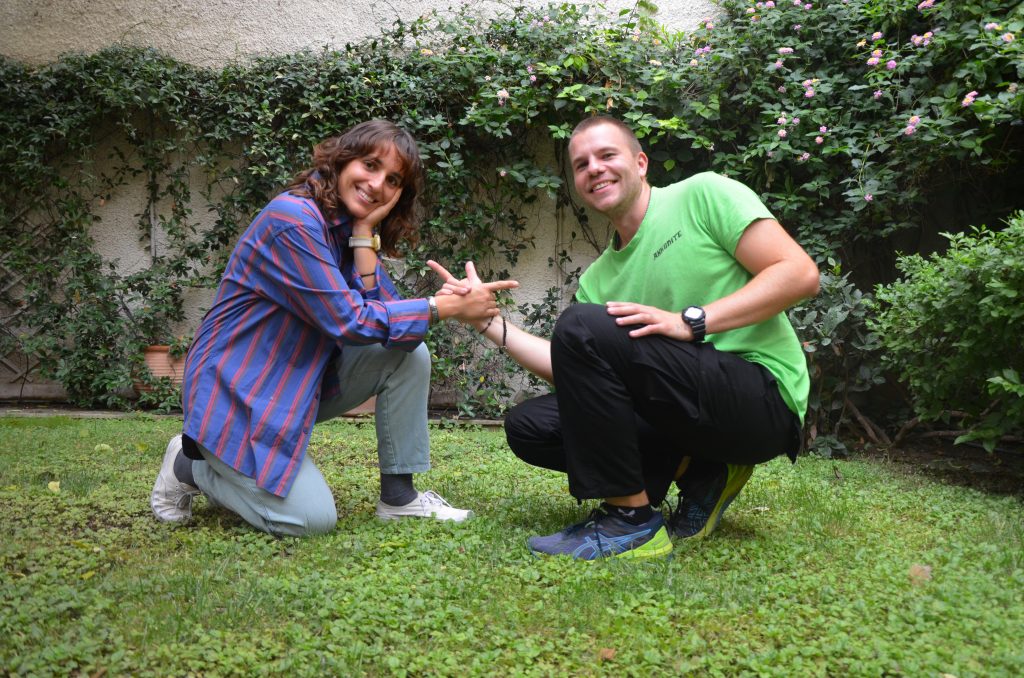
The conversation flows and I once again pick up the theme of ‘environmental setting’ in their work, because I’m curious of what else Walter and Eirini had going on for the theme. The word ‘observation’ is the first one Eirini comes up with, when discussing their working practices:
– We like to include observation in our practice, and experience in a sense that we were working with the environment, and the place where we are going. And first we are going to walk the environment and the landscape, we’re going to hike the area. Because this is how we will see information, sounds, tastes, the animals, the plants… I think after this we slowly started to develop some ideas of what we want to say about where we are now, how we would like to connect it with who we are, what we carry with us, where we have been and what we have done so far, says Eirini.
It is very fascinating to hear such an inspiration elaborated as thoroughly as Eirini does. She is very open and talkative on the process and elaborates it with admirable smoothness and ease. And she doesn’t stop there, but rather tells of the fruits of this mental thought-process.
In terms of ‘labours’ that followed, she and Walter sketched both individually and together. They planned, made small sculptures. Every now and then, they talked about books and articles they had been reading. As Eirini puts it, they were “reading and connecting different elements of what is interesting for us at the moment”. In sum, it is easy to acknowledge the term ‘observation’ and its results, which were many to say the least. As Eirini sums their artistic work:
– I think this is how it usually goes and a… it came to be, Eirini says.
Subsequently, Walter and Eirini found themselves in doing “some planning of a performance”. They saw the elements of what were in their surroundings, and they started to work with it. For example, they found an individual log lying around, of which they were both thinking about and eventually they both became interested in it. Walter was thinking of painting on it, which they both agreed would be a nice idea. The video of the performance followed the proceedings of this idea.

As with the main performance in Sykaminea though, it was a result of testing of ideas and encouraging an exchange of them with each other:
– It’s like a choreography of participating and arting and extracting information and ideas, and that’s how I think we kind of naturally support each other’s idea and art to it. And then it comes to a performance – it came to a video in that case, Eirini says.
Speaking of Sykaminea, the Hermitage residency was located between the residency of Skalas Skamias, which is close to the sea, and the village of Sykaminea, located in the mountainside. As Walter elaborates, this became ‘a gesture’, in which they would start to walk from the mountain path down towards the Hermitage. Different kinds of landscapes and views emerge from the mountains to the village near the sea, which hosts a chapel, and there are fishermen working. In the evenings, stars lit the sky all the way. All this, according to Walter, was a main source of inspiration for them both in terms of photography. As the place stands, the word ‘wholesome’ feels like a word that encapsulates the experience overall.
As the discussion goes on, it becomes apparent that ‘Hermitage’ is very fittingly chosen name, based on Walter’s and Eirini’s experience. For artists, the place provides a nice, comfy environment which is outside the norm for people, especially for those coming from afar.
As Walter’s comment illustrates, the place can also re-create earlier experiences:
– This thing of going there in the Hermitage, I’m thinking when I was living in Helsinki. On the weekends, I would go to my parent’s village, and we would collect mushrooms or something. It’s like… everything is different, the pace of the day is different, Walter says.
In all fairness, while listening to this artistic experience, the word ‘idealized’ comes to mind. But as it turns out though, this is a completely different image than what Walter and Eirini want to ‘maintain’ or ‘transmit’ as an idea in their works:
– You don’t want to keep it idealized – we are there to really understand why it is important to us in the contemporary society. And, why the practices are and were already heading into this direction. Trying to see it from a new perspective: what is life, that people live there? How can it help the rest of the people to go back to something that is important? But including everyone, like an inclusion. Which I think is very important, but the traditional conservative societies don’t have it, Eirini elaborates.
The discussion of how people are living their lives flows to the contemporary political challenges. In the midst of the turbulences that cross the geopolitical matters, peoples’ relationships with each other – inclusion and exclusion in particular – comes across vividly. This is mainly related to the area where Sykaminea is geographically located. Being on the north side of Lesbos, Sykaminea is practically right next to Turkey, standing only around 12 kilometres away from the border of the countries.
– There are a lot of stories of when the current refugee crisis started in around 2011–13, Walter says.
Around the time when the refugee and migrant situation took something of its current shape around 2015, the situation became more apparent. Within a year or so, one could see boats coming from the Turkish side.
– Geopolitically, it is like a hot pit for the current policy, Walter adds.
The phenomenon also illustrates the stark contrast of lack of planning and communication between the locals and the political authorities. To make the matters worse, the refugee and migrant situation creates a lot of confusion between the people on the move, locals and authorities, which results in varied acts of response from people:
– You can feel some kind of tension because of the situation that Greece is in for the past state and the refugees. Also, you can feel that people are tired because they are not being supported by the government and they are doing what they can do to the helpless people. Sometimes the tables turn and in a sense those people stop, they don’t want to help anymore. There are all sorts of controversy and, maybe you can even feel some kind of hate towards anyone… or anything. I think people are confused and unsupported and so it makes sense, Eirini ponders.
In the midst of all this, it becomes more evident what sorts of inspiration these events have for the artistical project in Sykaminea. The contrast between a hermitage and a mirror of the oncoming global matters becomes truly apparent and significant via our discussion. It gives a lot of food for thought as to why artistic projects can be done, what contexts they deal with, and what inspires them.
At this point, the discussion slowly halts for a little while. A small pause at our nice conversation room named after one Henrik Zilliacus (1908–1992).
But back to the project itself:
So, how would you say that this TelepART-grant overall helped you with this recent project?
– Yeah I think majorly. I mean, it helped us to do this move, to bring this project to life, from all aspects, Eirini says, with a cheerful voice.
– Ναί I think one thing which is a bit… it’s a big island, and there are not many public transports…which you need to use a lot. To go from Plomari to Sykaminea, we cannot go directly, we first have to to go to Mytilene [the main city of Lesbos], Walter says.
– … you always have to go back to the main city to be able to go to all other places, Eirini clarifies.
Straightforward it surely sounds, if only a little inconvenient. But fortunately, there are other solutions available:
– We were talking already that in the future, when we go back to the island… if we’re going to stay longer at some point we need to buy a car, Walter states.
– …or something, like a papaki [motorcycle] or…, Walter continues.
– …or a horse, Eirini adds.
[Laughs]
– … or a horse, Walter says, amused.
– … I would like a horse, or a donkey, Eirini says.
[Some more laugh]
Any plans you have for future – what lies ahead for you two?
– This winter we are moving to Finland, to Helsinki and we would like to find collaborators there, or maybe institutions. Maybe we engage with education that might be interesting for us. But at the same time, totally taking advantage of the Finnish countryside and what is happening there – what are the tools we could both use for our common individual practice, and at the same time being in contact with Athens, Eirini says.
…but there is more:
– We are having an exhibition in February; we are coming back. We can send the invitations when we know the exact date and the information officially, Eirini says.
Sounds fantastic, looking forward to that! (Readers, stay tuned!)
– … and during Spring, we’ll try to be on the island, so we can help with the olive grove, and see what there is for us, Walter and Eirini say, completing each other.
Sounds like a lot going on in this…?
– It is a lot. I think we are trying to find a nice, inspiring balance between living in the city and…being connected with a city life, but at the same time having our base somewhere in the countryside, Eirini says.
– Yeah, because you still need to come to the city for many things. So basically, you cannot only be in the countryside, Walter adds.
He gives a practical example:
– Even if you would have a very good internet connection, you would still… yeah, like, there are some things you can only do with a good internet, Walter says.
– First of all, if you get all of it you need all of it, Eirini replies.
[Laughs erupt across the room]
So, it comes down to having like – the best of both halves?
Their answer is a resounding “yes”.
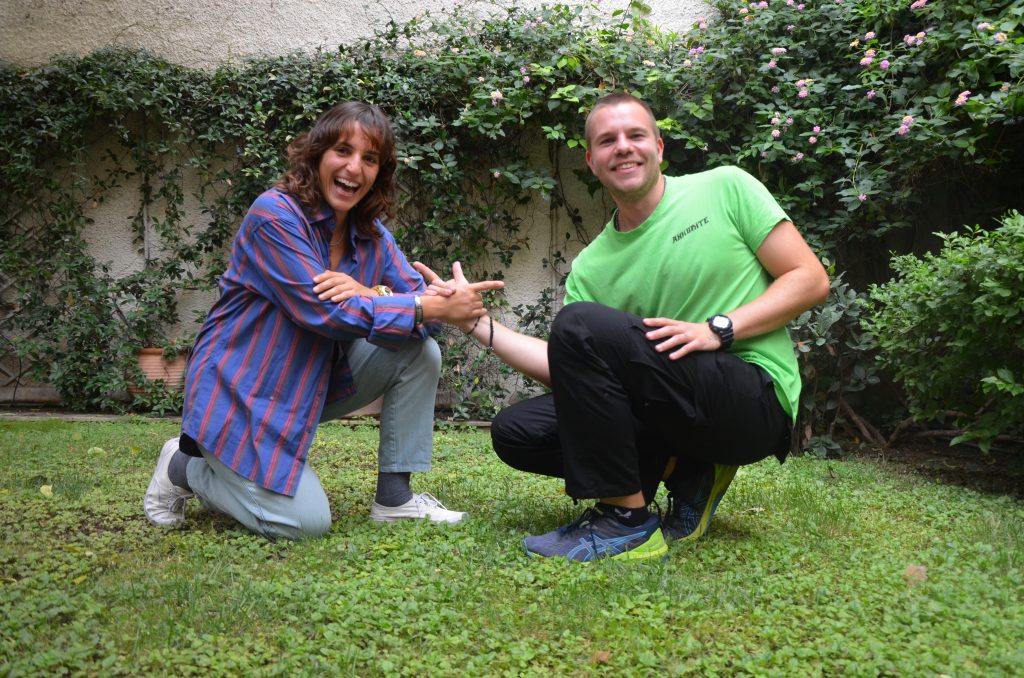
For Hermitage Sykaminea, see their website at https://hermitage-sykaminea.org/
For the artists’ portfolio, see the following Instagram profiles:
Walter Götsch: https://www.instagram.com/wbot/
Eirini Tiniakou: https://www.instagram.com/lesugarmorehoney/
Eirini’s website: https://orthodoxeyebrow.com/
As interviewed by: Miika Remahl (FIA Intern)
